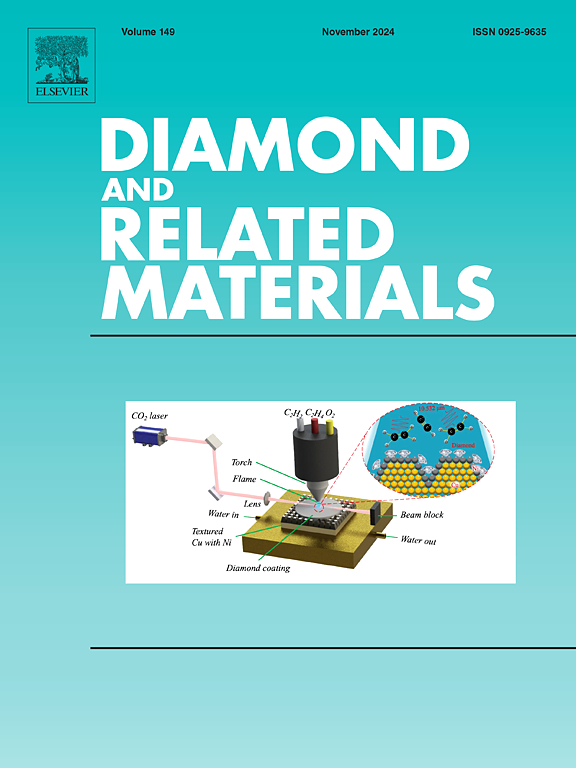可能的n型金刚石的2N/2P-Ga/Al/B共掺杂方案:基于GGA-PBE泛函的直接带隙优化第一性原理研究
IF 5.1
3区 材料科学
Q2 MATERIALS SCIENCE, COATINGS & FILMS
引用次数: 0
摘要
采用基于GGA-PBE泛函的第一性原理计算方法研究了共掺杂2N/2P-Ga/Al/B配合物的结构稳定性、电子和光学性质。在5种掺杂体系中,NCGaCN构型(N-C-Ga-C-N)的形成能最低(Ef =−1829 eV),稳定性最高,电离能最小(EI = 0.101 eV)。带结构和态密度分析表明,所有掺杂结构的带隙都减小了,其中NCGaCN体系的带隙减小幅度最大。所有系统均表现出直接带隙n型半导体特性。掺PCAlCP和PCGaCP体系的光学性能显著增强,其低能区介电常数分别从本禀金刚石的4.2提高到21.8和22.5。此外,nccnn掺杂体系的电导率达到21 S/m,光吸收系数达到5.5 × 105 cm−1。这些发现为金刚石半导体材料的发展提供了坚实的理论基础。本文章由计算机程序翻译,如有差异,请以英文原文为准。

2N/2P-Ga/Al/B co-doping scheme for possible n-type diamond: Direct bandgap optimization form first-principles study based on GGA-PBE functional
The structural stability, electronic and optical properties of diamond co-doped with 2N/2P-Ga/Al/B complexes were studied using first-principles calculations based on GGA-PBE functional. Among the five doped systems studied, the NCGaCN configuration (N-C-Ga-C-N) demonstrated the lowest formation energy (Ef = −1829 eV), highest stability, and smallest ionization energy (EI = 0.101 eV). Band structure and density of states analysis revealed reduced bandgaps in all doped structures, with the most significant reduction occurring in the NCGaCN system. All systems exhibited direct bandgap n-type semiconductor characteristics. The doped systems showed significantly enhanced optical properties, particularly in the PCAlCP and PCGaCP doped systems, where the dielectric constants in the low-energy region increased from 4.2 in intrinsic diamond to 21.8 and 22.5, respectively. Additionally, the conductivity of the NCBCN-doped system reached 21 S/m, and the light absorption coefficient of the NCGaCN-doped system achieved 5.5 × 105 cm−1. These findings provide a solid theoretical foundation for the development of diamond semiconductor materials.
求助全文
通过发布文献求助,成功后即可免费获取论文全文。
去求助
来源期刊

Diamond and Related Materials
工程技术-材料科学:综合
CiteScore
6.00
自引率
14.60%
发文量
702
审稿时长
2.1 months
期刊介绍:
DRM is a leading international journal that publishes new fundamental and applied research on all forms of diamond, the integration of diamond with other advanced materials and development of technologies exploiting diamond. The synthesis, characterization and processing of single crystal diamond, polycrystalline films, nanodiamond powders and heterostructures with other advanced materials are encouraged topics for technical and review articles. In addition to diamond, the journal publishes manuscripts on the synthesis, characterization and application of other related materials including diamond-like carbons, carbon nanotubes, graphene, and boron and carbon nitrides. Articles are sought on the chemical functionalization of diamond and related materials as well as their use in electrochemistry, energy storage and conversion, chemical and biological sensing, imaging, thermal management, photonic and quantum applications, electron emission and electronic devices.
The International Conference on Diamond and Carbon Materials has evolved into the largest and most well attended forum in the field of diamond, providing a forum to showcase the latest results in the science and technology of diamond and other carbon materials such as carbon nanotubes, graphene, and diamond-like carbon. Run annually in association with Diamond and Related Materials the conference provides junior and established researchers the opportunity to exchange the latest results ranging from fundamental physical and chemical concepts to applied research focusing on the next generation carbon-based devices.
 求助内容:
求助内容: 应助结果提醒方式:
应助结果提醒方式:


